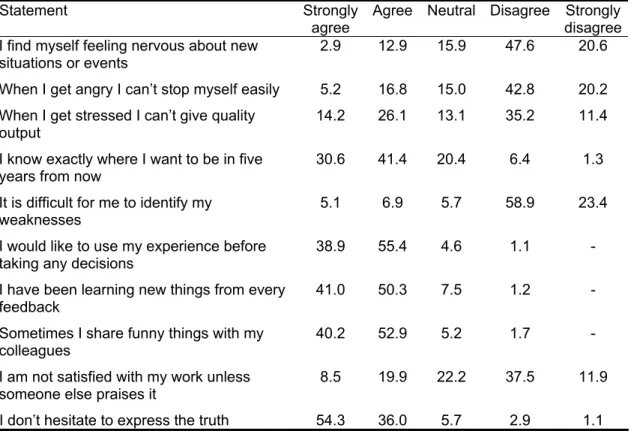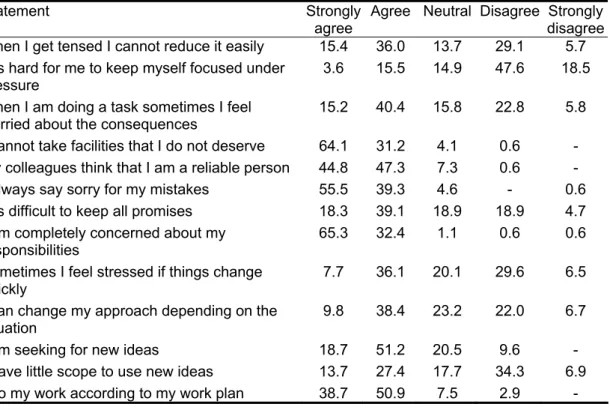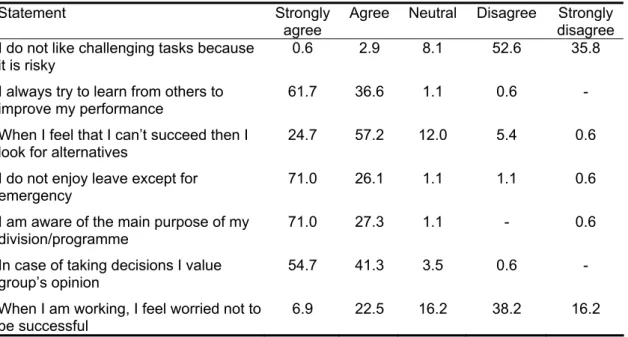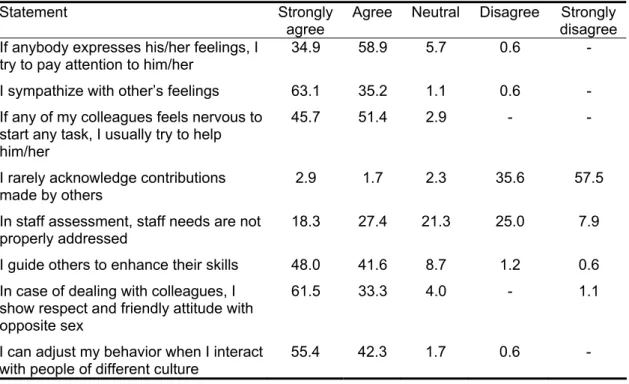Emotional intelligence therefore refers to "the ability to perceive and express emotions, assimilate emotions in the mind, understand and reason with emotions, and regulate emotions in oneself and others" (Mayer et al. 1999). There have been attempts to merge the emotional and social components of the EI construct to accommodate both emotional and social skills. To achieve this, we need to assess the social and emotional intelligence of BRAC employees.
Calculate the social and emotional intelligence (SEI) of the staff in terms of personal and social skills in the workplace. Respondents were informed about the purpose of the study and were free to participate. The average age of the respondents was almost 41 years, men around 42 years and women around 35 years (Table 2).
As expected, a positive relationship was observed between the age of respondents and the level of employment within BRAC. Respondent-based information Type of staff Age (mean±SD) Years of experience. mean±SD) Percentage of staff. Nearly 40% of respondents agreed that when they felt stressed they could not produce quality results.
Even though almost 90% of respondents liked to stick to their work plan, almost half of them reported that they could change their approach depending on the situation. Finally, more than 90% of the respondents agreed that they showed sensitivity with staff of opposite gender and different culture. Some 63% of respondents reported being able to influence others, and 87% reported being able to tailor their choice of wording to their audience.
In terms of self-completion, almost one-fifth of respondents reported that they did not want to raise questions that could lead to disagreement. Just over one-quarter of staff reported that they received a satisfactory rating for their good work. In terms of control, nearly a quarter of employees felt that they had difficulty satisfying their superiors.
Almost 70% of staff agreed that their superiors know how to make their subordinates more effective. It is likely that awareness of others' emotions and handling them appropriately can increase with age. Similarly, length of service in BRAC and staff gender were weakly and negatively associated with SEI score.
That is, the value of R2 explained 25.6% of the variability of the JS scores by respondent's age, experience, job level, and SEI components.

DISCUSSION AND RECOMMENDATION
Therefore, it can be said that the ability to take other people's feelings and perspectives into account, to be aware of colleagues' emotional needs, the ability to form relationships with colleagues and show understanding towards them largely determines job satisfaction. Nevertheless, the fact that the SEI set of components explains 25% of JS means that social and emotional skills are an important aspect in job satisfaction and consequently a more productive work environment. However, it must be argued that most of the research on EI in the workplace has been conducted in organizations with a very different scope to BRAC, e.g.
Therefore, it may well be the nature of BRAC and its mission that inevitably attracts employees with a reasonable level of social and emotional competence. Of course, this is not to say that there is no room for improving the staff's social and emotional skills. According to Boyatzis (2001), there are three reasons why a person might want to develop or improve his/her emotional intelligence.
Second, the incentive can be more personal, that is, someone just wants to improve themselves. A third possibility would be altruistic, in that one would want to help others develop emotional intelligence to pursue their goals. In the context of BRAC, the standard rules for SEI improvement (as proposed by Boyatzis, 1982 and refined by Goleman, 2001) can apply, regardless of the fact that effectiveness can be defined differently by division and level: there must be congruence between the competencies, values and interests of an employee, the demands of a specific job and the environment of the organization.
For example, when assessing employees' competencies, their awareness of themselves and where they want to be within an organization should also be considered. However, this was intended as an initial assessment to identify the SEI competency level, the 'culture' among BRAC staff. In order for the staff to be informed, responsible and caring, and to be so despite significant obstacles, it must first be kept in mind that people usually learn these issues from their families.
The trainers must therefore be aware, because the aim of the training must be to change the employee's attitude level. In terms of training programs, it is important to address social and emotional issues and their effective practice in the office. Pupils also recognize that some effort must be made if they want to succeed in the social and emotional sphere.
In discussing the findings of this study, we must highlight two possible limitations:. a). If our current findings are anything to go by, we could cautiously say that the higher the level, the greater the competence of the SEI. We did not clarify whether workers scoring low on SEI measures would be classified as "desirable" who could benefit from a training program, nor did we place a "passing grade" on self-assessment scores that would indicate such a thing.
Finally, because this is a largely descriptive study, supervisors cannot meaningfully apply the findings to increase their department's performance. However, we must take into account the findings on workplace satisfaction and that, as a rule, a culture of care and cooperation among employees contributes to efficiency. On the other hand, trainers also adopt SE skills and encourage them, otherwise employees will not feel their importance.
In promoting self-motivation, different psychological and psychotherapeutic techniques have been used, which activate an individual's 'performance drive' through various intellectual exercises. Such training programs were delivered to workers at all levels, directors, executives and subordinates. Staff talked about the techniques, trainers should have established some problem solving techniques that can help boost SE skills.
For newly recruited staff, an orientation program on SEI can be included to make them more responsive. Emotional Intelligence: Why It May Matter More Than IQ for Character, Health, and Lifelong Performance, New York: Bantam Books. Emotional intelligence and job satisfaction: Testing the mediating role of positive and negative affect at work, personality and individual differences, Science Direct.
The construction and validation of a new scale for measuring emotion regulation: personality and individual differences.
ANNEX
Overall reliability score
Item-total statistics of self awareness
Item-total statistics of self-regulation
Item-total statistics of social-awareness
Item-total statistics of social skills
Item-total statistics of job satisfaction








